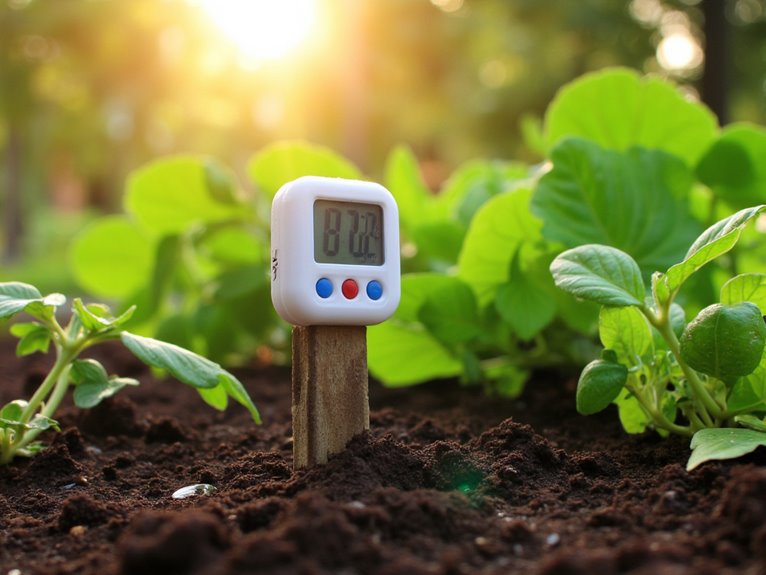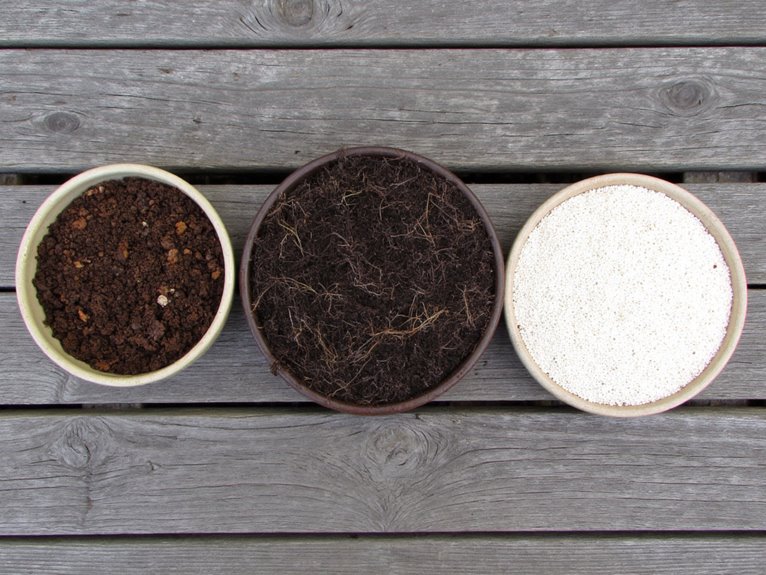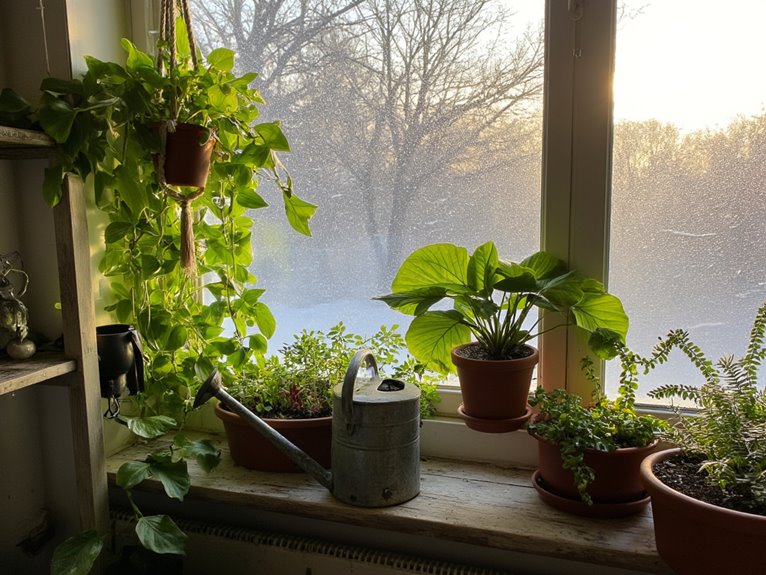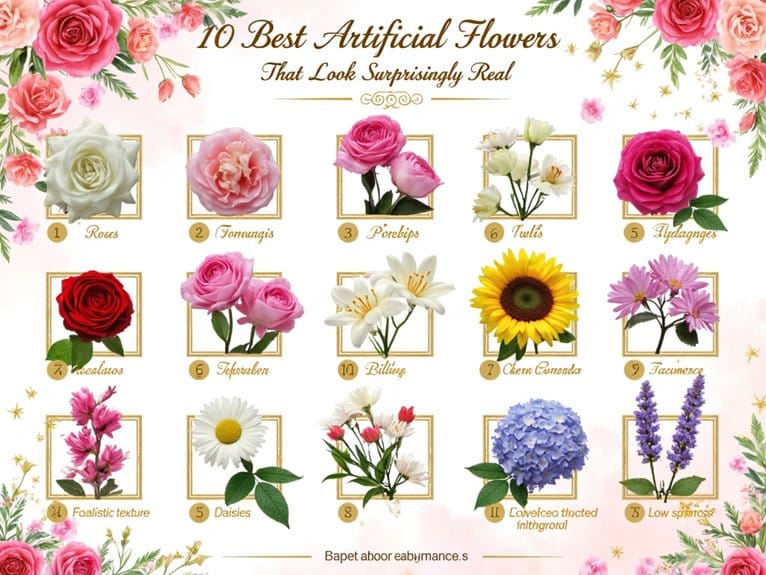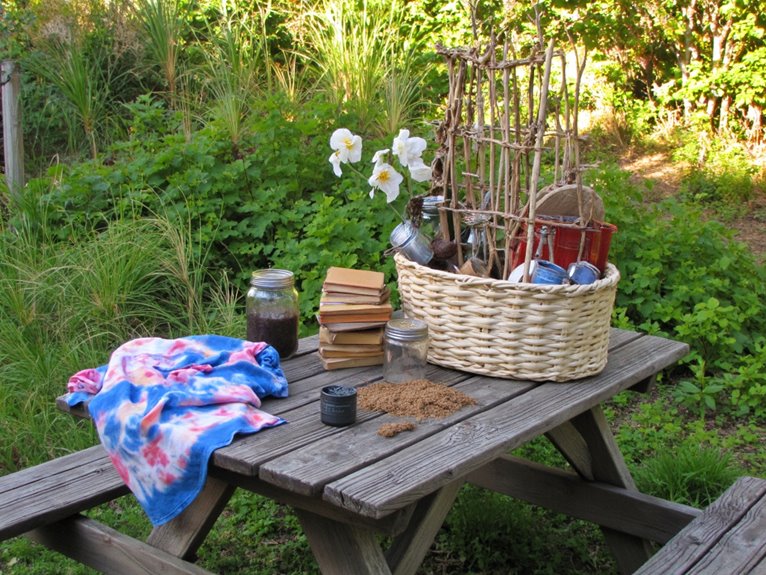Plants for Indoor Gardening Beginners (With Care Instructions)
Start with snake plants or ZZ plants—they thrive with minimal care while cleaning your air. These tough growers prefer indirect light and only need occasional watering. For brighter spots, try aloe vera or rubber plants, which store water and handle droughts well. Pothos and philodendron add colorful variegation with indirect light and moderate moisture. Keep temperatures stable between 60-75°F and watch for signs of overwatering. With these basics covered, you’re ready to grow green! Don’t forget to explore specific care tips as your collection grows.
Notable Insights
- Snake plants and ZZ plants are low-maintenance, filtering toxins and improving air quality with minimal care.
- Aloe vera and rubber plants thrive in bright indirect light, offering air purification and dramatic foliage for beginner spaces.
- Pothos and philodendron add vibrant color with easy care—place in indirect light and water based on soil dryness.
- Peace lilies purify air with elegant blooms, needing consistent moisture and monthly fertilization for optimal health.
- Provide well-draining soil, stable temperatures between 60°F–75°F, and appropriate humidity to ensure plant success.
Low-Maintenance Wonders: Snake Plant and ZZ Plant
Whether you’re new to gardening or busy with life’s demands, the snake plant and ZZ plant offer perfect companions—these tough, versatile wonders thrive with minimal effort while quietly improving your space. Both plants boost indoor air quality by filtering toxins and releasing oxygen, especially at night. Their sleek forms enhance plant aesthetics, bringing calm energy to any room. Snake plants even regulate humidity, helping ease allergies and dry skin. ZZ plants, with their waxy leaves, add texture without requiring much care. These low-maintenance options adapt to varied light and watering needs, making them ideal for beginners or small spaces. Place them strategically to maximize both beauty and function in your home.
(1) Snake plants specifically purify air by removing harmful chemicals like formaldehyde and benzene from the environment.
Bright Spaces Made Better: Aloe Vera and Rubber Plant Care
After mastering the resilience of snake plants and ZZs, you’re ready to brighten your space with aloe vera and rubber plants—two species that transform light into life while offering practical perks beyond mere decoration. Aloe vera benefits extend beyond its sleek form; its gel-like sap soothes burns and skin irritations, making it both beautiful and useful. Place it in bright indirect light, avoiding direct sun to prevent scorching.
For Rubber Plant Aesthetics, their broad leaves add a bold statement piece to any room. Water thoroughly but infrequently, letting the soil dry between sessions. These plants thrive together, improving air quality and bringing nature’s touch indoors—perfect for expanding your green horizons with confidence.
OriginNative Habitat as a desert plant makes aloe vera exceptionally drought-tolerant, requiring minimal watering once established.
Variegated Beauty: Pothos and Philodendron Tips
Once you’ve mastered the basics of indoor plant care, adding variegated wonders like pothos and philodendron can bring a fresh pop of color to your space. These plants thrive with proper light placement—aim for east or west windows to avoid direct sun damage while still offering enough brightness. Pothos especially loves indirect light, whereas both species can survive in lower light but will grow more slowly. For soil selection, opt for well-draining mixes like perlite or pine bark to prevent root rot. Water pothos when the soil is dry halfway down, and philodendron enjoys slightly moister conditions between waterings. Remember to adjust based on your home’s specific lighting and climate.
Pothos, which originates from tropical Southeast Asia, has been cherished for centuries not only for its air-purifying qualities but also for its symbolic association with wealth and luck in various cultures.
Air-Purifying Elegance: Peace Lily Essentials
If you’ve been enjoying the variegated charm of pothos and philodendron, you might find peace lilies equally enchanting don’t worry, they’re not as demanding. These plants bring peace lily benefits like air purification and serene beauty to your space. For peace lily care, aim for bright indirect light and keep soil consistently moist but not soggy.
| Light Needs | Water Requirements |
|---|---|
| Bright indirect | Water when top inch dry |
| Low tolerance | Avoid overwatering |
| Mist for humidity | Check regularly |
Place them near windows, fertilize every 6 weeks, and repot annually. Choose pots with proper drainage holes to prevent root rot and maintain healthy moisture levels. With proper care, peace lilies thrive and reward you with elegant white blooms.
Creating the Perfect Environment: Temperature, Light, and Humidity
While many focus on choosing the right plants, crafting the ideal environment often determines gardening success—so let’s explore how to maintain suitable temperature ranges, provide appropriate lighting, and manage humidity levels for your indoor collection. Most plants thrive between 60°F and 75°F, with nighttime temperatures 10-15°F lower to support recovery. Avoid sudden temperature fluctuations that stress foliage or cause drop. Position plants near south-facing windows for high light, or use grow lights for low-light spaces. For optimal plant nutrition, consider full-spectrum LED grow lights that provide coverage from 380nm-780nm wavelengths, including essential red and blue light ranges. Indoor humidity is vital for tropical species—group plants together or use pebble trays to maintain moisture. By balancing these factors, you’ll create a stable home for your greenery to flourish.
Water Wisdom: How Much (and How Well) to Water Your Plants
Water is essential for plant life, yet finding the right balance can be tricky—too much drowns roots, while too little wilts leaves. Establishing good water timing requires observing your plants’ unique needs rather than sticking to rigid schedules. Check soil moisture regularly with your finger or by lifting the pot; a dry pot signals it’s time to water.
Moisture monitoring tools like moisture meters or visual cues (shriveled leaves, sunken soil) help avoid overwatering. Always use room-temperature water and guarantee proper drainage to prevent waterlogging. Tropical plants may need weekly watering, while succulents thrive with deeper but less frequent soakings.
Remember that environmental factors like temperature and light exposure influence how quickly your plants consume water. Quality potting soil with enhanced drainage properties helps prevent root rot while maintaining the moisture balance your herbs need to thrive. By developing a consistent routine that prioritizes timing over frequency and monitoring soil conditions rather than clock times, you’ll cultivate healthier indoor gardens without the guesswork.
Growing Stronger: Fertilization, Pruning, and Propagation Basics
Once you’ve mastered the basics of watering, nurturing your indoor garden gets a lot stronger by understanding how to feed, shape, and expand your plants. Fertilization techniques start with checking N-P-K ratios on labels – never use lawn fertilizers! Dilute to half-strength initially, especially in spring, and feed during active growth phases. Pruning methods remove dead tissue and encourage bushier growth; always cut above leaf nodes. Balance chemical and organic options based on plant needs, and remember micronutrients like iron and magnesium. For propagation, stem cuttings in water or soil work best – snip 4-6 inches from healthy plants. Keep tools clean to prevent disease spread, and only prune during active growth seasons. With these basics down, your plants will thrive year-round!
Frequently Asked Questions
How Do I Know When It’s Time to Repot My Plant?
You need to repot when your plant shows clear signs like roots popping out of drainage holes or forming circles around the pot — indicating it’s rootbound. Check if new growth slows, leaves shrink, or the soil dries fast. These are key repotting signs that your plant needs more space and fresh soil.
Is Tap Water Safe for My Houseplants to Use?
Yes, tap water can be safe for your houseplants but depends on its quality and mineral content. Let it sit to remove chlorine, use filtered water for sensitive plants, and avoid high-mineral water for species that prefer acidic soil.
How Should I Prune a Tree-Like Indoor Plant?
You should prune a tree-like indoor plant in spring or early summer using sharp shears. Focus on pruning techniques like cutting just above leaf nodes and removing dead growth. Different tree varieties need varying approaches—some tolerate heavy cuts, others require gentle shaping. Always disinfect tools to protect your plants.
How Often to Feed Plants With Liquid Fertilizer?
You should feed plants with liquid fertilizer every 3–4 weeks using full strength, or more frequently with diluted solutions. Fertilizer types vary in concentration, so match your feeding schedule to plant growth stages and seasonal changes. Don’t fertilize during dormancy either—you’ll just stress the roots.
Can Any Plants Thrive in Bathroom Conditions?
Yes, plenty of plants thrive in bathrooms – humidity loving plants like ferns and anthuriums prefer the moist air, while low light species such as ZZ plants and snake plants handle dim conditions well. Just avoid overwatering!
On a final note
With these resilient plants as your starting point, indoor gardening becomes an achievable joy rather than an intimidating task. By understanding each plant’s unique needs and creating the right environment, you’ll watch your green space thrive. Remember to water thoughtfully, provide appropriate light, and nourish with care—your home will thank you with lush beauty and fresh air. Keep learning, experimenting, and enjoying every leafy success.

